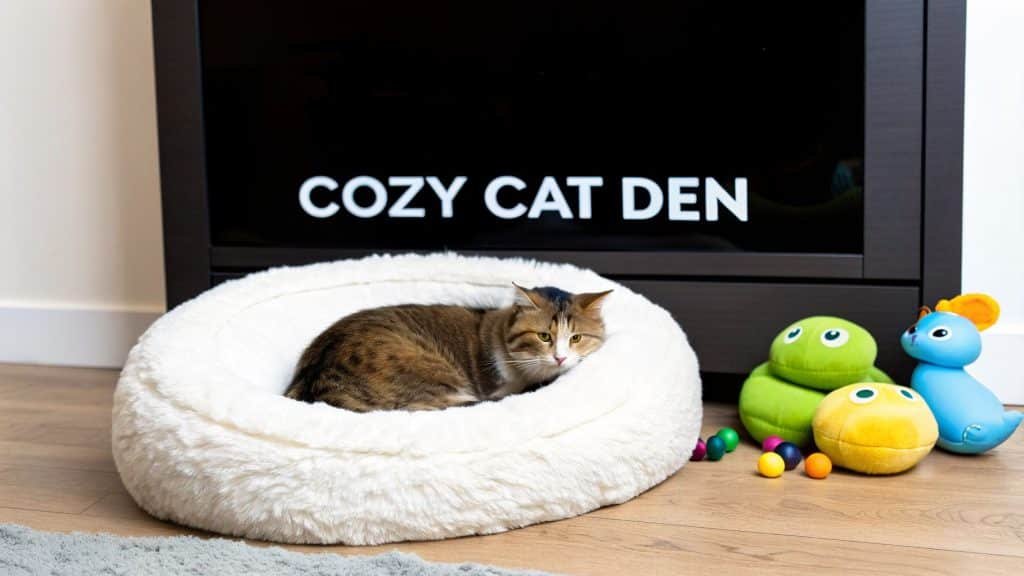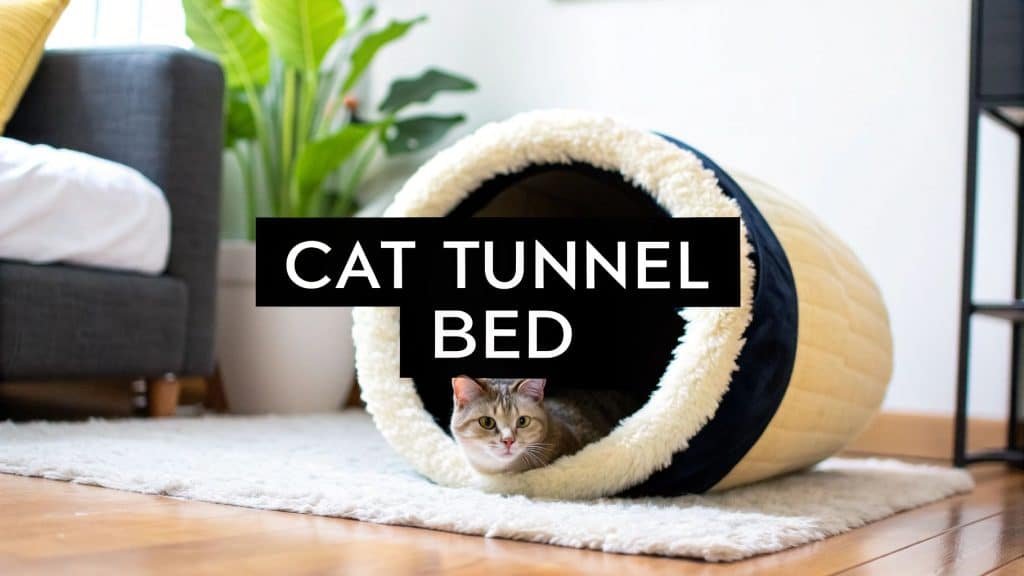Why Cats Love a Cat Toy Ball With Feathers
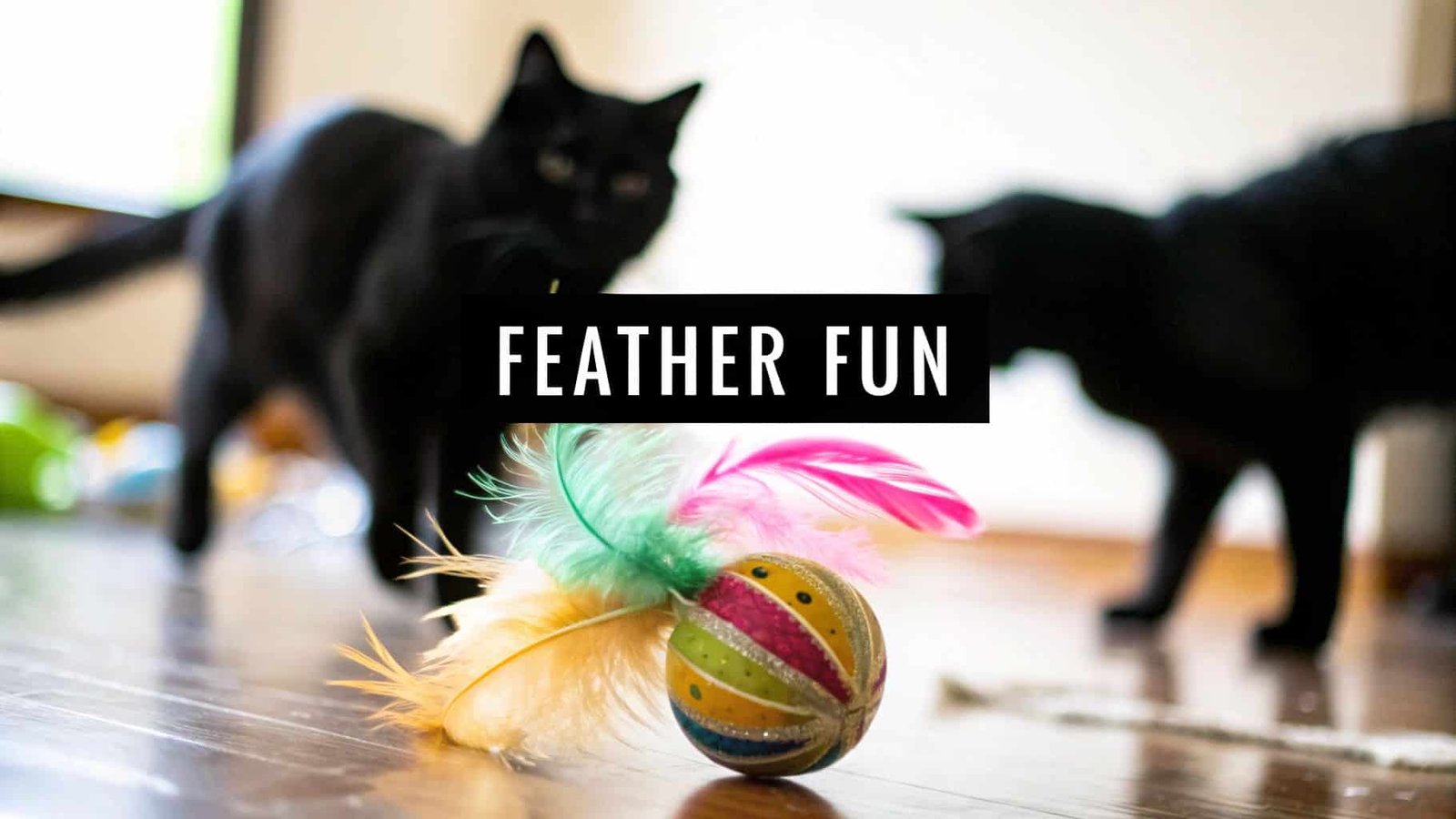
It might just look like a simple ball with some fluff, but a cat toy ball with feathers is a direct line to your cat’s inner hunter. This classic combo—a rolling ball and fluttering feathers—is expertly designed to mimic the sights and sounds of natural prey, flipping the switch on their most deeply ingrained instincts.
Tapping into Your Cat’s Wild Side
Ever seen your cat’s pupils dilate as they stare down a feathered toy skittering across the floor? That intense, laser-like focus is more than just play. It’s a glimpse into their primal world as a predator. For our indoor companions who don’t get the chance to stalk real prey, this kind of stimulation is absolutely vital for their mental and physical well-being.
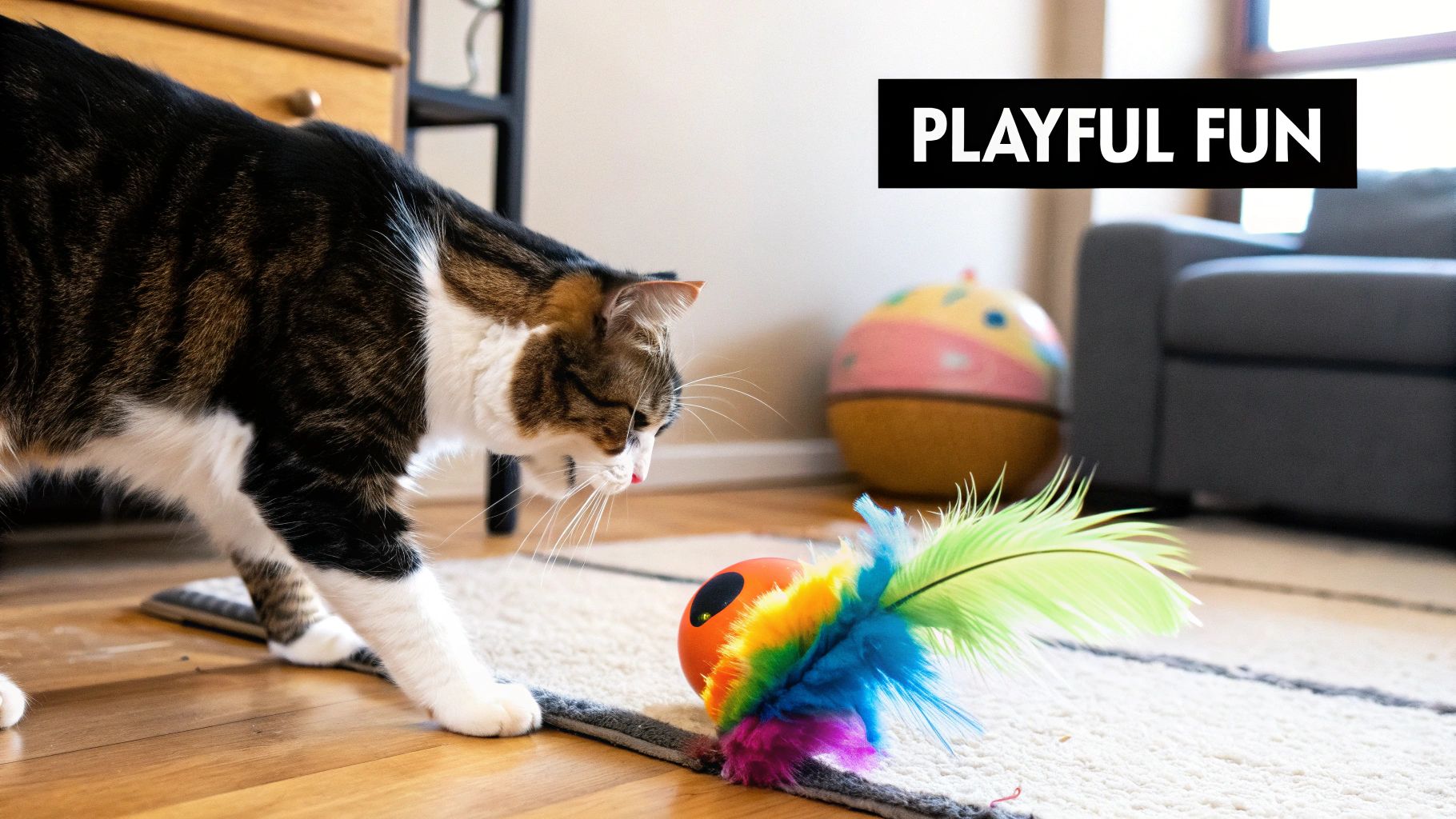
A Safe Way to Hunt
Think of a feathered toy ball as a “safe hunt.” It gives your cat the chance to go through the entire predatory sequence—from the silent stalk to the triumphant pounce—without anything actually getting hurt. This cycle is incredibly satisfying for them.
- Stalking: The toy sits still, letting your cat crouch low, watch, and plot their attack.
- Chasing: You toss the ball, and its erratic rolling motion triggers an immediate, explosive chase.
- Pouncing: Those fluttering feathers create the perfect target for a satisfying pounce and “capture.”
Going through these motions provides a much-needed outlet for all that coiled-up energy. Without it, you might see that energy come out as boredom, anxiety, or even destructive habits.
A great toy does more than just keep a cat busy. It provides a necessary outlet for their natural behaviors, which leads to a happier, more well-adjusted friend. This simulated hunt is a cornerstone of their well-being.
Why the Feathers Are Key
The feathers are really the secret ingredient here. They flutter and twitch erratically, perfectly imitating a small bird or scurrying critter, which is something a cat’s brain is hardwired to find irresistible.
Plus, the light, airy texture is super satisfying for them to bite and carry around after a successful “kill.” It’s the perfect finale to their hunt.
At the end of the day, giving your cat a toy like this isn’t just about staving off boredom. It’s about respecting their nature and providing a fulfilling way for them to be who they are. When you understand that, playtime stops being just a game and becomes a powerful way to enrich their life and support their happiness.
Here is the rewritten section, designed to sound completely human-written and natural.
Why Your Cat Is Obsessed with Feathers and Balls
Ever wondered what’s going on in your cat’s head when they go absolutely wild for a simple feathered ball? It’s not just random fun—it’s pure, hardwired instinct. Every bat, pounce, and chase taps into a powerful internal program called the predatory sequence.
Think of it as an echo of their ancestors’ life in the wild. A cat’s brain is finely tuned to hunt, and a good toy lets them act out this entire drama right in your living room. The unpredictable roll of the ball catches their eye, which is designed to notice even the slightest movement. Then, the whisper-soft rustle of the feathers mimics the sound of small prey, flipping the switch in their brain from “nap time” to “hunt mode.”
Tapping Into the Instinctive Hunt
The predatory sequence is more than just a simple chase; it’s a complete, satisfying cycle. A feathered ball is so effective because it lets your cat check off all the key boxes of a successful hunt:
- Stalking: You’ll see them crouch low, eyes locked on the target, tail twitching as they calculate the perfect moment to move.
- Chasing: The second the ball rolls, they explode into action, driven by that primal need to pursue.
- Pouncing: They leap and use their paws to trap their “prey.”
- Capturing: The final, satisfying moment comes when they grab the toy, maybe giving it a little “kill bite” to complete the sequence.
Going through these steps is incredibly important for a cat’s mental and physical health. Without a healthy outlet for all that energy, a bored cat can quickly become an anxious or destructive one. Suddenly, your sofa corners and dangling charger cords start looking a lot like prey.
A cat doesn’t learn to hunt; they are hunters. Giving them toys that let them act on that instinct is one of the best things you can do for their well-being, especially if they live indoors.
It’s no surprise that as more of us bring cats into our families, the demand for these kinds of enriching toys is growing. In the U.S., household cat ownership has climbed from 27.3% back in 1996 to 32.1% in 2024. This makes sense when you consider that 84.7% of owners now think of their pets as part of the family, and are more willing than ever to invest in their health and happiness. You can explore more about these market trends and their impact on pet care.
So, when you toss a feathered ball to your cat, you’re doing more than just playing. You’re giving them a way to be the magnificent little predators they were born to be, resulting in a happier, more balanced companion.
How To Choose The Perfect Feathered Toy Ball
Picking out the right cat toy ball with feathers can feel a bit like a treasure hunt. With so many options on the shelves, how do you know which one your cat will actually play with? The secret isn’t just grabbing the brightest, fluffiest ball; it’s about matching the toy to your cat’s unique personality and making sure it’s safe.
First, think about your cat’s age and energy. A bouncy, energetic kitten might go absolutely bonkers for a lightweight jingle ball they can chase and swat for hours. On the other hand, a laid-back senior cat might get more enjoyment from a puzzle ball that slowly dispenses their favorite treats. It’s all about finding what clicks with their natural instincts.
Material And Durability Matter
When it comes to cat toys, safety is non-negotiable. Always look for toys made with non-toxic glues and natural feathers. The last thing you want is your furry friend chewing on something packed with harmful chemicals. Durability is a close second. A good toy needs to hold up against some serious clawing and biting without falling apart and becoming a choking hazard.
Before you buy, give the toy a quick inspection. Does it feel solid? Are the feathers attached firmly? If it feels flimsy or you can easily pull bits off, it’s best to leave it on the shelf. Nothing is more important than your cat’s safety.
This image shows what a well-designed, engaging toy looks like.
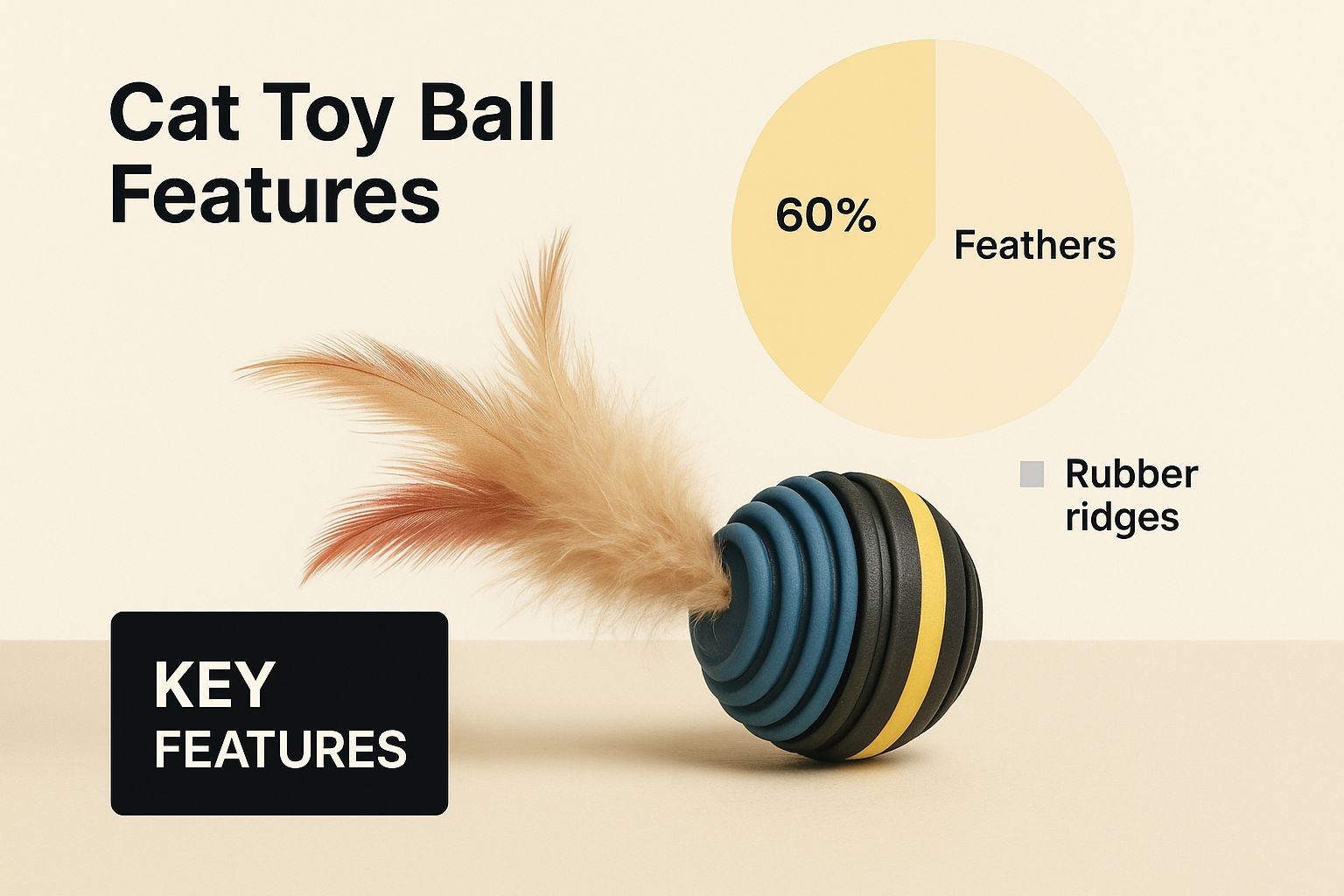
Notice how the different textures, like rubber and feathers, work together. That combination is what keeps a cat interested and ensures the toy can handle some roughhousing.
Match The Toy To Your Cat’s Play Style
To really nail your choice, you need to understand the different kinds of feathered balls out there. Each one is designed for a specific type of play, so you’re not just buying an object—you’re providing an enriching experience. If your cat is a big scratcher, you might also consider adding a sturdy cat scratching ball to their collection to give them a healthy outlet for that instinct.
Your cat’s personality is the ultimate guide. A smart cat who gets bored easily might love an electronic ball that moves on its own, while a timid cat might prefer a simple, quiet toy they can bat around at their own pace.
Let’s dive into the most common options so you can pick the perfect one.
Comparing Feathered Cat Toy Ball Types
This table breaks down the best feathered cat ball for your cat based on their age, energy, and personal play style.
| Toy Type | Ideal for Cats Who | Key Benefits | Potential Downsides |
|---|---|---|---|
| Simple Jingle Ball | Love to chase and are stimulated by sound. | It’s lightweight and easy for them to bat around. The jingle provides satisfying auditory feedback. | The internal bell can become a choking hazard if the ball breaks open. |
| Catnip-Infused Ball | Need a little extra encouragement to get moving. | The scent is incredibly enticing for most cats, helping to reduce stress and inspire play. | The catnip effect fades over time, and a small percentage of cats don’t react to it at all. |
| Electronic Moving Ball | Are highly active, intelligent, and get bored quickly. | It mimics the unpredictable movement of prey, which is fantastic for solo play sessions. | It needs batteries, and the noise or sudden movements can sometimes intimidate shy cats. |
By considering these different styles, you can move beyond just guessing and confidently choose a toy that will bring your cat hours of happy, stimulating fun.
The Rise of Enrichment-Focused Cat Toys
If you’re looking for the perfect cat toy ball with feathers, you’re already part of a major, positive shift in how we think about our pets. The days of a simple ball of yarn being “good enough” are long gone. Today, cat owners know that mental workouts and an interesting environment are just as crucial as a full food bowl.
This isn’t just a feeling; the numbers back it up. The global cat toy market hit a value of about USD 1,053 million in 2024. Experts expect it to jump to USD 1,581 million by 2031. This boom is happening because more of us are bringing cats home and are happy to spend a little more to keep them happy. You can discover more about cat toy market projections and see what’s fueling this growth yourself.
It’s More Than Just a Toy
Toy makers are definitely paying attention. We’re seeing more interactive and even tech-heavy toys designed to tap right into a cat’s natural hunting instincts. But here’s the interesting part: even the fanciest electronic gadget often uses classic, irresistible triggers like the flutter of a feather. It just goes to show that you can’t beat biology.
This trend isn’t just about selling more products; it’s about a collective movement toward providing our pets with more fulfilling, stimulating lives. Your decision to seek out an enriching toy is a modern, thoughtful approach to pet ownership.
Ultimately, when you invest in a quality toy, you’re doing more than just buying an object. You’re actively boosting your cat’s happiness and overall well-being. This focus on enrichment makes playtime truly count. Of course, a great nap is just as important, so after a good play session, a comfortable resting spot is key. Check out our curated selection of high-quality beds and mats to give your cat the perfect place to relax.
Keeping Playtime Safe and Fun
A great toy is a safe toy, and when it comes to a cat toy ball with feathers, a little bit of vigilance goes a long way. Think of yourself as your cat’s personal safety inspector—their well-being is always priority number one. A quick check before and after play can stop a potential problem in its tracks.
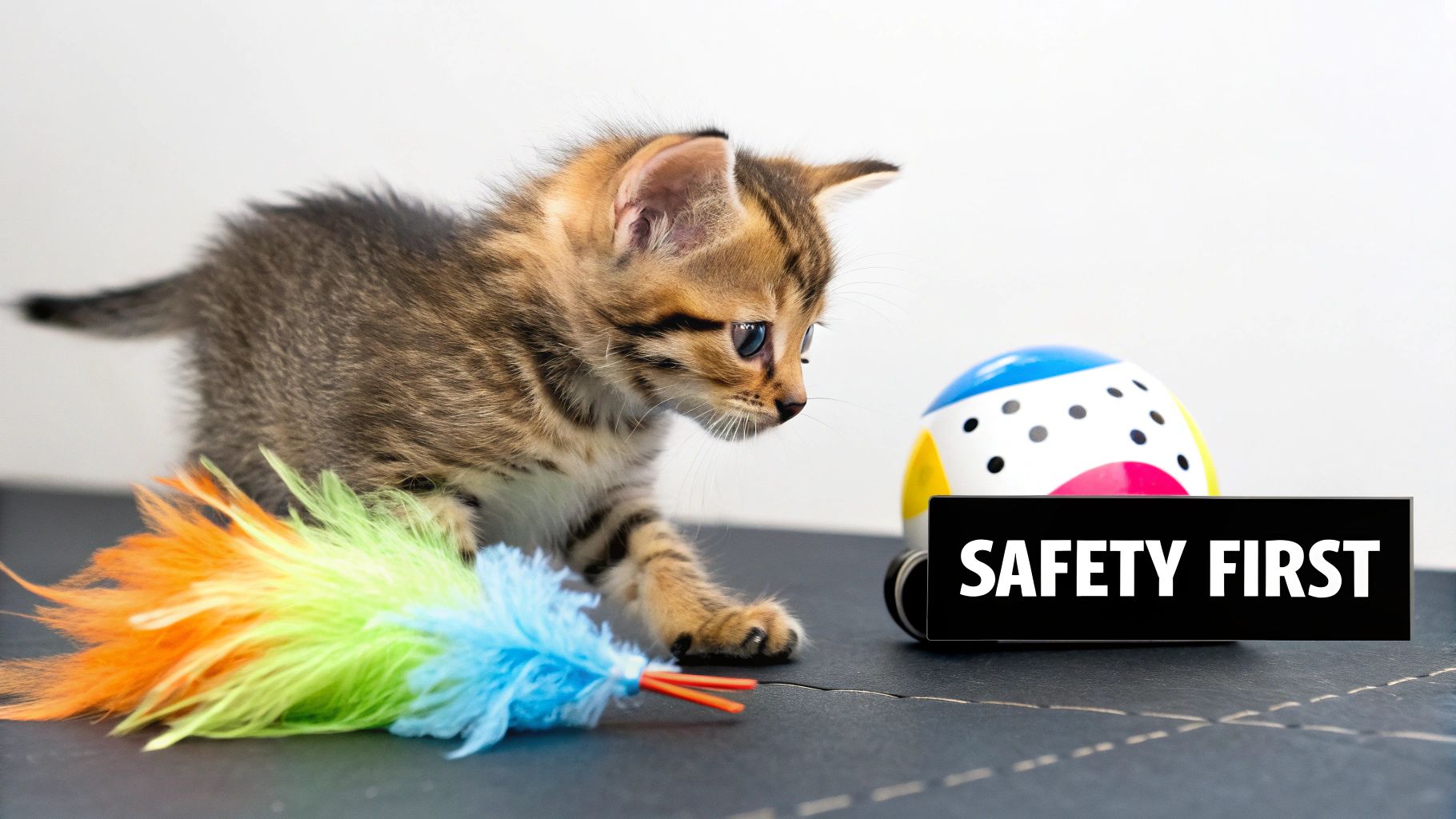
This really just means keeping an eye on them during playtime, especially with toys that have small or delicate parts. You should never leave a feathered toy out when you’re not around. A determined cat could easily chew off and swallow pieces, which is a serious choking or digestive hazard.
Your Quick Toy Check-Up
Get into the habit of doing a regular “toy check-up.” It only takes a second and is the best way to catch any developing dangers before they become a real issue.
Here’s what you should be looking for:
- Loose Feathers: Give the feathers a gentle tug. If they come out easily, it’s probably time to either fix the toy securely or say goodbye to it.
- Cracked Plastic: Look over the ball for any cracks, sharp edges, or other signs of wear and tear. A damaged ball can easily cut your cat’s mouth or paws.
- Frayed Strings or Cords: If there are any strings attached, make sure they are fully intact and not unraveling. These can become a serious ingestion or entanglement risk.
Toys aren’t meant to last forever. When a favorite toy starts falling apart, it’s a sign of many happy playtimes, but it’s also your cue to replace it to keep your cat safe.
Thankfully, as more cat owners prioritize safety, manufacturers are listening. We’re seeing more non-toxic and eco-friendly options hit the market, with a bigger push toward biodegradable and recyclable materials. You can learn more about these eco-conscious trends in the cat toy market to help you make better choices.
Of course, keeping your cat safe also includes their environment and hygiene. For more tips and products, feel free to check out our selection of top-tier grooming and cleaning supplies.
Got Questions About Feathered Cat Toys? We’ve Got Answers.
Even the perfect toy can leave you with a few questions. To help you feel completely confident, we’ve put together answers to the most common things cat owners ask about a cat toy ball with feathers. Let’s clear things up so you and your kitty can get right back to the fun.
Think of this as your go-to guide for making sure playtime is always safe, engaging, and worry-free.
Are the Dyed Feathers Actually Safe for My Cat?
This is one of the most important questions you can ask, and we’re glad you’re thinking about it. The short answer is: it depends on the dye. Reputable brands that care about your cat’s well-being will only use non-toxic, pet-safe colorants. This means there’s no harm if your cat gives the feathers a good chew.
When you’re shopping, keep an eye out for labels that specifically state “pet-safe dyes” or “natural vegetable dyes.” If a toy is brightly colored and you can’t find any information confirming the dye is safe, your best bet is to play it safe and choose one with natural, undyed feathers.
How Often Should I Swap Out My Cat’s Toys?
Ever notice your cat getting bored with a toy that used to be their favorite? That’s “playtime boredom,” and it’s easy to prevent. A great strategy is to rotate their toys every few days to a week.
- Keep a few toys in play: Don’t overwhelm them. Having 3-4 different types of toys out at once is plenty.
- Hide the others: Store the rest of the collection somewhere out of sight, like in a drawer or a closet.
- Make old toys new again: When you reintroduce a toy after a week, it’ll feel like a brand-new surprise, reigniting their excitement and natural hunting instincts.
This simple habit keeps your cat’s world interesting and ensures they never get tired of that awesome feathered ball.
What if My Cat Eats a Feather?
Seeing your cat swallow a feather can be a little scary, but try not to panic. In most situations, a single, small, soft feather will pass right through their digestive system without causing any trouble.
The real concern is when a cat ingests something more substantial. A large, stiff feather, a whole clump of feathers, or any plastic bits from a broken toy could create a risk for an intestinal blockage.
After they’ve swallowed something, just keep a close eye on them. If you notice any signs of distress like vomiting, acting unusually tired, or suddenly losing their appetite, it’s time to contact your veterinarian immediately. When it comes to potential blockages, getting professional advice right away is always the safest move.
At Ur Pet Store, we know that a happy pet starts with great care. Check out our entire collection of safe, engaging, and high-quality pet supplies designed to make your furry friend’s life better. You’ll find everything you need with free shipping on all orders at https://urpetstore.com.


